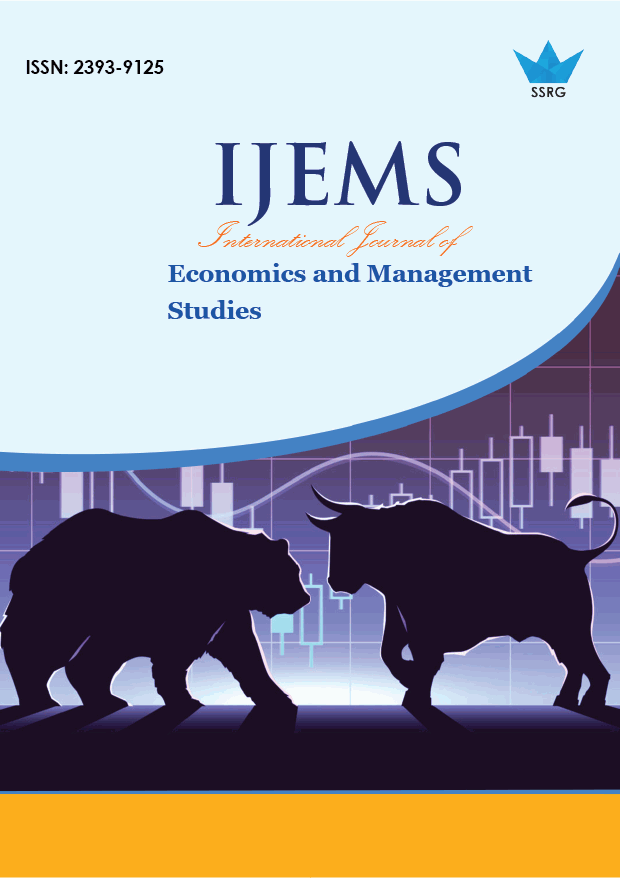Economic Growth, Unemployment, and Income Inequality in Sulawesi: A SEM-PLS Analysis of Regional Development Dynamics

| International Journal of Economics and Management Studies |
| © 2025 by SSRG - IJEMS Journal |
| Volume 12 Issue 9 |
| Year of Publication : 2025 |
| Authors : Ahmad, Muhamad Armawaddin, Fajar Saranani, La Ode Samsul Barani, La Tondi, Rendy Hidayat, Erwin |
How to Cite?
Ahmad, Muhamad Armawaddin, Fajar Saranani, La Ode Samsul Barani, La Tondi, Rendy Hidayat, Erwin, "Economic Growth, Unemployment, and Income Inequality in Sulawesi: A SEM-PLS Analysis of Regional Development Dynamics," SSRG International Journal of Economics and Management Studies, vol. 12, no. 9, pp. 63-72, 2025. Crossref, https://doi.org/10.14445/23939125/IJEMS-V12I9P106
Abstract:
This study investigates the relationship between Gross Regional Domestic Product (GRDP), Unemployment, and income inequality in six provinces of Sulawesi during 2010–2022 using Structural Equation Modeling–Partial Least Squares (SEM-PLS). The model employs a regional reflective approach, where provincial indicators represent latent constructs of growth, labor market performance, and Inequality. Bootstrapping results show that GRDP significantly reduces Unemployment, though with modest effect sizes, supporting Okun’s Law. Unemployment positively influences Inequality, indicating labor market exclusion as a key determinant of income disparity. GRDP also directly affects Inequality, but the coefficient magnitude is negligible, consistent with the Kuznets Hypothesis. The model explains 59.1% of unemployment variance and 84.4% of inequality variance, underscoring its explanatory power. Findings suggest that growth alone cannot guarantee inclusivity without policies promoting job creation, skill development, and equitable opportunity distribution. Limitations include the exclusion of other determinants and a focus on Sulawesi alone. Future research should extend the framework to other regions of Indonesia and incorporate additional variables.
Keywords:
GRDP, Unemployment, Inequality, SEM-PLS, Sulawesi, Inclusive growth.
References:
[1] Stefan Dercon, “Rural Poverty: Old Challenges in New Contexts,” The World Bank Research Observe, vol. 24, no. 1, pp. 1-28, 2009.
[CrossRef] [Google Scholar] [Publisher Link]
[2] Arief Anshory Yusuf, and Andy Sumner, “Growth, Poverty, and Inequality under Jokowi,” Bulletin of Indonesian Economic Studies, vol. 51, no. 3, pp. 323-348, 2015.
[CrossRef] [Google Scholar] [Publisher Link]
[3] Robert J. Barro, “Inequality and Growth in a Panel of Countries,” Journal of Economic Growth, vol. 5, no. 1, pp. 5-32, 2000.
[CrossRef] [Google Scholar] [Publisher Link]
[4] Martin Ravallion, “Inequality and Globalization: A Review Essay,” Journal of Economic Literature, vol. 56, no. 2, pp. 620-642, 2018.
[CrossRef] [Google Scholar] [Publisher Link]
[5] N. Gregory Mankiw, David Romer, and David N. Weil, “A Contribution to the Empirics of Economic Growth,” Quarterly Journal of Economics, vol. 107, no. 2, pp. 407-437, 1992.
[CrossRef] [Google Scholar] [Publisher Link]
[6] Laurence Ball, Daniel Leigh, and Prakash Loungani, “Okun’s Law: Fit at 50?,” Journal of Money Credit Bank, vol. 49, no. 7, pp. 1413 1441, 2017.
[CrossRef] [Google Scholar] [Publisher Link]
[7] Simon Kuznets, “Economic Growth and Income Inequality,” The American Economic Review, vol. 45, no. 1, pp. 1-28, 1955.
[Google Scholar] [Publisher Link]
[8] Takuma Kunieda, and Masashi Takahashi, “Inequality and Institutional Quality in a Growth Model,” Evolutionary and Institutional Economics Review, vol. 19, no. 1, pp. 189-213, 2022.
[CrossRef] [Google Scholar] [Publisher Link]
[9] W. Arthur Lewis, “Economic Development with Unlimited Supplies of Labour,” The Manchester School, vol. 22, no. 2, pp. 139-191, 1954.
[CrossRef] [Google Scholar] [Publisher Link]
[10] Ravi Kanbur, and Juzhong Zhuang, “Urbanization and Inequality in Asia,” Asian Development Review, vol. 30, no. 1, pp. 131-147, 2013.
[CrossRef] [Google Scholar] [Publisher Link]
[11] Gary S. Becker, Human Capital: A Theoretical and Empirical Analysis with Special Reference to Education, 1994.
[Google Scholar] [Publisher Link]
[12] Daron Acemoglu, Simon Johnson, and James A. Robinson, “Reversal of Fortune: Geography and Institutions in the Making of the Modern World Income Distribution,” The Quarterly Journal of Economics, vol. 117, no. 4, pp. 1231-1294, 2002.
[CrossRef] [Google Scholar] [Publisher Link]
[13] Badi H. Baltagi, Econometric Analysis of Panel Data, Third Edition, 2005.
[Google Scholar] [Publisher Link]
[14] Joseph F. Hair et al., A Primer on Partial Least Squares Structural Equation Modeling (PLS-SEM), Second Edition, 2017.
[Google Scholar] [Publisher Link]
[15] Joseph F. Hair et al., Partial Least Squares Structural Equation Modeling (PLS-SEM) Using R, Classroom Companion: Business. Cham: Springer International Publishing, 2021.
[CrossRef] [Google Scholar] [Publisher Link]
[16] Claes Fornell, and David F. Larcker, “Evaluating Structural Equation Models with Unobservable Variables and Measurement Error,” Journal of Marketing Research, vol. 18, no. 1, pp. 39-50, 1981.
[CrossRef] [Google Scholar] [Publisher Link]
[17] Jörg Henseler, Christian M. Ringle, and Marko Sarstedt, “A New Criterion for Assessing Discriminant Validity in Variance-Based Structural Equation Modeling,” Journal of the Academy of Marketing Science, vol. 43, no. 1, pp. 115-135, 2015.
[CrossRef] [Google Scholar] [Publisher Link]
[18] Ravi Kanbur, and Juzhong Zhuang, “Urbanization and Inequality in Asia,” Asian Development Review, vol. 30, no. 1, pp. 131-147, 2013.
[CrossRef] [Google Scholar] [Publisher Link]
[19] Martin Ravallion, “Inequality is Bad for the Poor,” Inequality is Bad for The Poor, pp. 1-50, 2005.
[CrossRef] [Google Scholar] [Publisher Link]
[20] Eric A. Hanushek, and Ludger Woessmann, “Education, Knowledge Capital, and Economic Growth,” The Economics of Education: A Comprehensive Overview, pp. 171-182, 2020.
[CrossRef] [Google Scholar] [Publisher Link]
[21] Cliff Attfield, and Jonathan R.W. Temple, “Balanced Growth and the Great Ratios: New Evidence for the US and UK,” Journal of Macroeconomics, vol. 32, no. 4, pp. 937-956, 2010.
[CrossRef] [Google Scholar] [Publisher Link]
[22] Olivier Blanchard, and Lawrence F. Katz, “What We Know and Do Not Know about the Natural Rate of Unemployment,” Journal of Economic Perspectives, vol. 11, no. 1, pp. 51-72, 1997.
[CrossRef] [Google Scholar] [Publisher Link]
[23] Wynne W. Chin, “The Partial Least Squares Approach for Structural Equation Modeling,” Lawrence Erlbaum Associates Publishers, pp. 295-336, 1998.
[CrossRef] [Google Scholar] [Publisher Link]
[24] Ganesh Rauniyar, and Ravi Kanbur, “Inclusive Growth and Inclusive Development: A Review and Synthesis of Asian Development Bank Literature,” Journal of the Asia Pacific Economy, vol. 15, no. 4, pp. 455-469, 2025.
[CrossRef] [Google Scholar] [Publisher Link]

 10.14445/23939125/IJEMS-V12I9P106
10.14445/23939125/IJEMS-V12I9P106